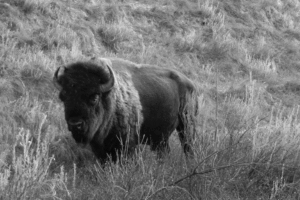Discovering a family connection to Claydon
Posted on September 28, 2017 by Maple Creek
Dominique Liboiron
It was a trip five years in the making. Back in 2012, my cousin Charlie Michel invited me to tour a quarter of land that belonged to my great-grandfather. Since then, Charlie and I kept saying we’d go sometime, but it wasn’t until Sept. 21 that we made the trip happen.
Charlie lives in Eastend and farms with his wife Maria. They own the land that used to belong to my great-grandfather Euclide Liboiron. My great-grandfather was born in 1887 in St. Polycarpe, Que., and in 1929 he moved his family to a farm a few miles north of Claydon. The Liboirons lived there until 1937 at which point they moved to Ponteix. Charlie and the locals still call the land the Liboiron quarter all these years later.
Charlie showed me where the house and buildings once stood, but nothing remains. The only indication anyone used to live there is a hump of dirt that’s a few feet higher than the stubble. Apparently, it marks where the trees were, but they’ve been gone for decades.
Charlie’s dad knew my great-grandfather and said the Liboirons were quite a large family, even by French-Canadian and Catholic standards of that era. There were 12 children, but not all of them survived.
Standing in what had once been my great-grandfather’s farmyard, I looked south towards the US border and pretended I was him gazing in the same direction 90 years ago and seeing much the same scenery.
After visiting the former farmstead, Charlie cut cross country on a prairie trail that took us through the Arena Pasture. He remembered some of the oldtimers who lived there when he was still a boy and he recalled hunting in the area with his uncles.
After leaving the prairie trail, we followed a gravel road to Old Man on His Back. I’d been there a few times in years passed, but never realized how close it is to the Liboiron quarter.
The unbroken land there looks a lot like what my ancestors would have seen when they farmed not far away. In a sense it was like returning to a time when buffalo roamed and the deer and the antelope played.
Old Man on His Back protects a large unbroken tract of grassland where countless unique, diverse and fascinating plant and animal species can be viewed. Access to Old Man on His Back is free, which makes it an appealing destination for a Sunday drive.
The nature preserve is the realisation of a man’s dream. Like his father and grandfather, Peter Butala ranched in the area that would become Old Man on His Back. The Butala family owned the property from 1913 to 2001.
With retirement approaching, Butala worried about the future of the land he loved. With so much of the original prairie gone, he wanted to save some of what was left. Nature Conservancy Canada shared a similar concern and was interested in preserving native grasslands. Nature Conservancy Canada sought a large block of land where animal populations could remain viable.
In 2001, Peter and Sharon Butala transferred ownership of 20 sections of land to Nature Conservancy Canada. In May of 2004, 25 male and 25 female genetically-pure bison from Elk Island National Park near Edmonton were released on the 13,000 acres of prairie and June 14, 2006, marked the official opening of a new 1,200 sq. foot interpretative centre. The eastern section of the building showcases the history of the land and the cultural legacy of ranching. The western section houses researchers and NCC staff. Private donations funded the project.
The state of the grassland ecosystem at Old Man on His Back proves what ranchers have always known. It demonstrates that ranching and conservation can exist hand in hand.
The sanctuary is an excellent place to enjoy wildlife. Mule deer and white-tailed deer inhabit the preserve and occasionally share their surroundings with elk and moose. Small herds of pronghorn antelope live there, as well.
It is very important to maintain large blocks of unbroken grasslands if we wish to preserve the long list of endangered or threatened species that call the Prairies home. Burrowing owls, loggerhead shrike, swift fox and reptiles like the northern leopard frog and a wide variety of grass and flowers all live at Old Man on His Back.
There are also historical and artistic reasons to preserve grasslands. The Boundary Commission, passed to the south of Old Man on His Back in the early 1870s while mapping the Canada/US border. The Boundary Commission used astronomy to find the 49th parallel before the days of GPS navigation. Shortly thereafter, the North-West Mounted Police grazed their horses in what is still known as the Remount Pasture.
Many writers have been inspired by the area’s beauty. Wallace Stegner’s family homesteaded south of Old Man on His Back along the Montana border. Stegner wrote Wolf Willow for which he was award the Pulitzer Prize. Peter Butala’s wife Sharon drew inspiration from their land to pen “Perfection of the Morning.” She also worked in tandem with photographer Courtney Milne to create “Old Man on His Back, Portrait of a Prairie Landscape.” Her prose captures the area’s soul and Courtney Milne’s photographs make its beauty more apparent to the untrained eye.
If you’re looking for a reason to visit the area, I’m told the Claydon Fowl Supper is one of the best around. It will be held at the hall from 4:30 p.m. to 6:30 p.m. Tickets are $16.
NEWS PHOTO DOMINIQUE LIBOIRON
Since 2003, Old Man on His Back has been home to a herd of genetically-pure bison. A mature bull can weigh up to 2,000 pounds at measure six feet high at its hump. Bison aren’t the only residents of Old Man on His Back. The 13,000-acre property also provides habitat for many other prairie plants and animals.



Leave a Reply
You must be logged in to post a comment.